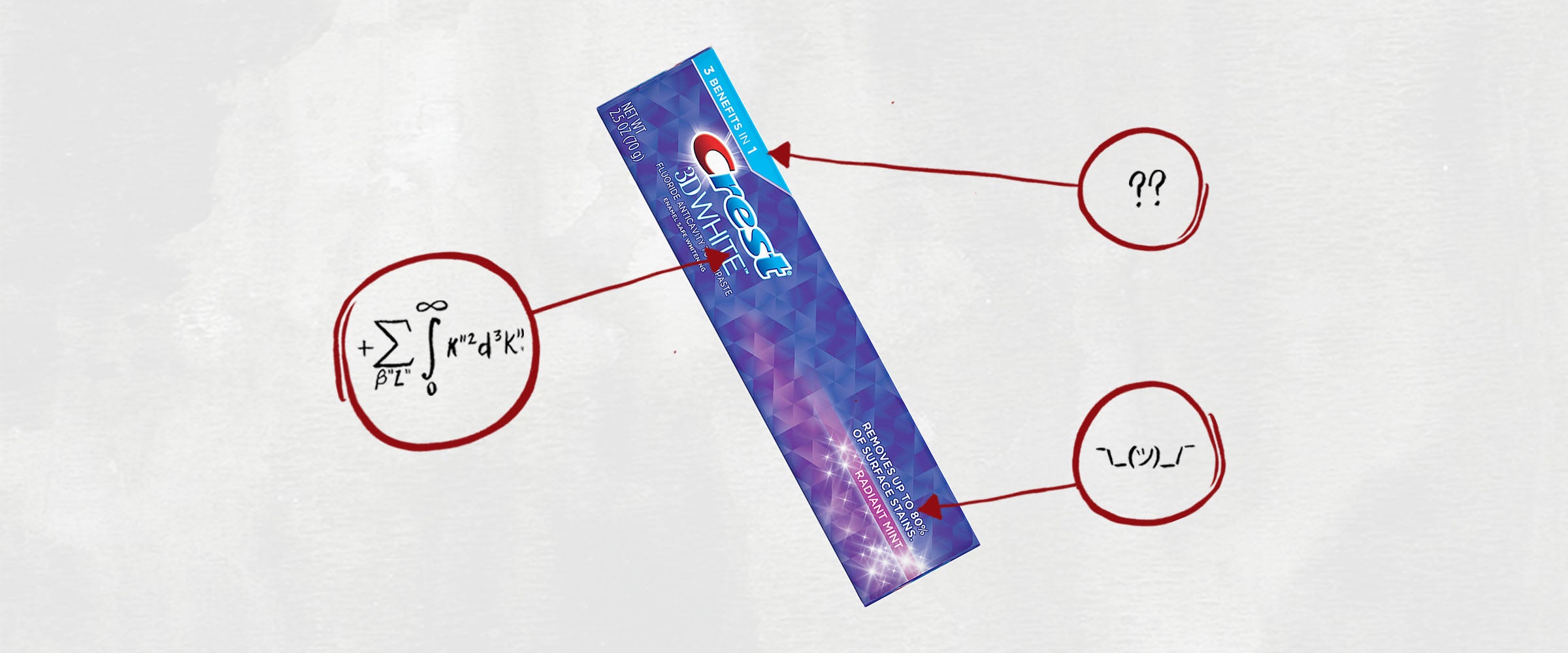We’re often told that you should never eat anything (or put anything on your body) if you don’t recognize everything on the ingredients list. But since most of us have no idea what xanthan gum or potassium benzoate are — or more importantly, what they’re doing to our bodies — we’re decoding the ingredients in the many things Americans put in (and on) themselves with the help of an expert.
This edition: Crest 3D White Radiant Mint Whitening Toothpaste, which is made from 14 separate ingredients that we’ve broken down in the exact order they appear online.

The Ingredients
1) Sodium Fluoride: This is the active ingredient in many toothpastes. It basically prevents tooth decay by bonding with the outer layer of our teeth, making them stronger and more resistant to cavities.
However, I recently wrote about how, when kids use too much toothpaste, they tend to swallow a lot of fluoride, which can actually damage their teeth. “The fluoride can get incorporated into their enamel and cause something called fluorosis,” pediatric dentist Jonathan Shenkin explained. “Fluorosis typically shows up as little white streaks that aren’t visible to people, but a small percentage of people — two or three percent — have very severe fluorosis that looks brown and pitted.”
Fortunately, adults don’t have to worry about this — they don’t tend to swallow toothpaste, and fully-grown teeth aren’t affected by fluorosis — but the takeaway here should be that swallowing toothpaste is a bad idea.
2) Water: This can be found in rivers and lakes.
3) Sorbitol: Sorbitol is a sugar alcohol often used as a sweetener in lieu of actual sugar (unlike sugar, sorbitol does not cause cavities). Those with gastrointestinal conditions should watch out for this ingredient — studies show that it’s an effective laxative and can cause diarrhea, bloating, gas and abdominal pain.
4) Hydrated Silica: This can be used as a thickener for gel toothpaste, a mild abrasive for cleaning or as a whitening agent.
5) Disodium Pyrophosphate: In the case of toothpaste, this ingredient probably functions as a chelating agent (a substance that prevents deterioration during processing and storage by binding the minerals within the product). It’s also “generally recognized as safe” by the Food and Drug Administration.
6) Sodium Lauryl Sulfate: This is commonly used in cosmetics as a foaming agent. It, however, has long had a bad reputation for being toxic and possibly causing cancer; that said, one recent review concludes that the only dangers SLS really poses is as a skin and eye irritant: “The perception that SLS is a threat to human health is not scientifically supported, and claims made to the contrary should be regarded as false and misleading.”
Furthermore, as Snopes notes, “Three different agencies — the Occupational Safety and Health Administration (OSHA), the National Toxicology Program (NTP) and the International Agency for Research on Cancer (IARC) have all rated SLS as being non-carcinogenic.”
All that said, ingesting sodium lauryl sulfate can cause nausea, vomiting and diarrhea, so again, try not to swallow this toothpaste.
7) Flavor: Where the mint taste comes from.
8) Cellulose Gum: Cellulose gum is a common thickening agent. Consuming large amounts of it may add bulk to your stool and have a laxative effect, according to the FDA. So once more, say it with me: “I will not eat this toothpaste!”
9) Sodium Hydroxide: This is commonly used to neutralize the pH levels in toothpaste, which basically improve the overall efficacy of the product, since some of the other, stronger ingredients in toothpaste can be quite acidic. It’s also “generally recognized as safe” by the FDA.
10) Sodium Saccharin: Sodium saccharin is the solid form of an artificial sweetener called saccharin. During the 1970s, controversial studies performed on rodents found the ingredient to be carcinogenic, though subsequent studies on both people and primates found that saccharin was indeed safe for human consumption. One of those studies, published in the Journal for the National Cancer Institute in 1998, found that primates exposed to saccharin on a daily basis from birth showed no adverse effects.
11) Carbomer: Carbomer is a term used for a series of polymers usually made from acrylic acid, which all sounds science-y, but the end result is basically just a fluffy, white powder used as the basis for this toothpaste.
12) Mica: Mica is a naturally occurring mineral dust used in many cosmetics, including toothpaste, for its sparkle. It can also act as a mild abrasive to help polish teeth.
13) Titanium Dioxide: This basically prevents discoloration. Unfortunately, the European Chemical Agency has concluded that titanium dioxide may cause cancer when inhaled, which means — let’s all say it together now — eating toothpaste is bad.
14) Color: Artificial colors have a bad reputation, but as physician and biochemist Cate Shanahan, author of Deep Nutrition: Why Your Genes Need Traditional Food, explained during our analysis of Doritos, studies arguing this are a bit flawed: “I’ve always been of the opinion that studies claiming artificial colors can cause cancer are irrelevant because [in the studies] they use really high amounts of the artificial colors — like, a million times more than you’d ever get [in your] food [throughout your lifetime].”
All in all, the average person’s liver should be able to break down whatever minuscule amount of artificial coloring we accidentally consume with toothpaste.
The Takeaway
These ingredients are pretty standard as far as toothpaste goes (although, there are more natural toothpastes out there that don’t contain potentially unnecessary ingredients, like sodium saccharin).
One thing that should be made clear: Whitening toothpastes, like this one, don’t change the actual color of your teeth — they just contain a larger amount of mild abrasives than regular toothpastes. They can, however, remove surface stains, potentially giving the teeth a whiter appearance.
Overall, though, brushing regularly with this toothpaste should prevent your teeth from falling out. Just remember, no matter how tempting it might be, don’t eat it, idiot.

